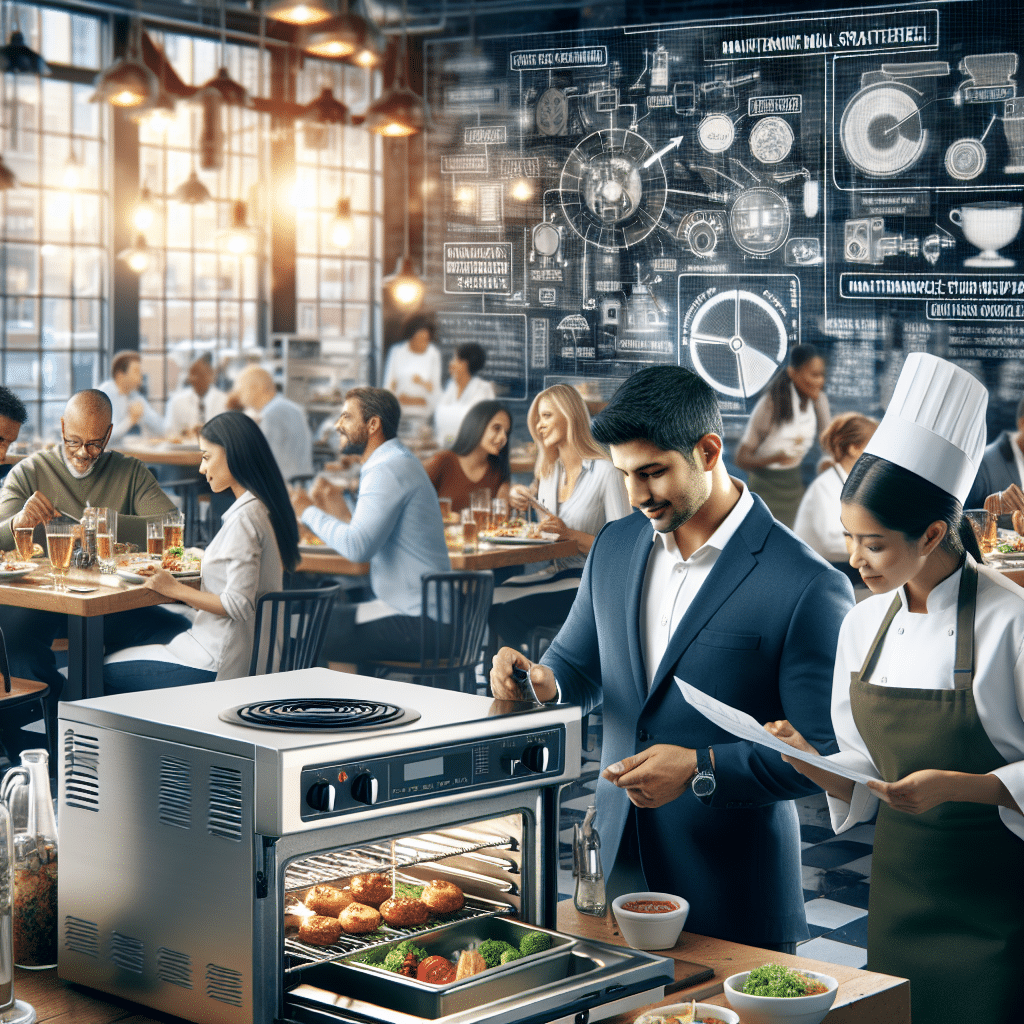The Role of Equipment Maintenance and Repair Strategies in a Restaurant’s Business Model
-
Table of Contents
- Essential Equipment Maintenance and Repair Strategies for Restaurant Success
- Understanding the Importance of Equipment Maintenance
- Strategic Maintenance: A Proactive Approach
- Repair Strategies: Minimizing Downtime
- Cost-Benefit Analysis of Maintenance and Repair
- Integrating Maintenance into the Business Model
- Conclusion: The Role of Equipment Maintenance and Repair in Restaurant Success
- Enhance Your Restaurant’s Offerings with ETprotein’s High-Quality Protein Products
Essential Equipment Maintenance and Repair Strategies for Restaurant Success

The success of a restaurant hinges on various factors, from the quality of the food and the efficiency of the service to the ambiance of the dining area. However, one critical aspect that often goes unnoticed is the role of equipment maintenance and repair strategies in a restaurant’s business model. Proper upkeep of kitchen appliances, refrigeration units, and other essential tools is vital for ensuring smooth operations, minimizing downtime, and ultimately contributing to a restaurant’s profitability and customer satisfaction.
Understanding the Importance of Equipment Maintenance
Restaurants rely heavily on their equipment to deliver high-quality food and services. A breakdown can lead to significant disruptions, affecting not only the day’s revenue but also the establishment’s reputation. Regular maintenance helps prevent unexpected malfunctions and extends the lifespan of the equipment, which is crucial for managing costs and maintaining a competitive edge.
Strategic Maintenance: A Proactive Approach
Adopting a proactive approach to equipment maintenance involves regular check-ups and servicing to identify potential issues before they escalate. This strategy can be broken down into several key components:
- Preventive Maintenance: Scheduled inspections and servicing of equipment to ensure everything is in working order.
- Condition-Based Maintenance: Monitoring the actual condition of equipment to determine when maintenance should be performed.
- Predictive Maintenance: Using advanced techniques and data analysis to predict when equipment failure might occur and preemptively addressing it.
By implementing these strategies, restaurants can avoid the high costs associated with emergency repairs and equipment replacement, which can be substantial. According to a study by the National Restaurant Association, unexpected kitchen equipment failures can cost a restaurant between $800 and $1,200 per hour in lost business.
Repair Strategies: Minimizing Downtime
When equipment does fail, having an effective repair strategy is crucial. This includes:
- Trained Staff: Ensuring that staff members are trained to identify common issues and perform basic repairs.
- Reliable Service Providers: Establishing relationships with professional repair services that can respond quickly and efficiently when needed.
- Inventory Management: Keeping a stock of essential spare parts to avoid delays in repairs due to parts unavailability.
Restaurants that have a solid repair strategy in place can significantly reduce the impact of equipment failure on their operations. For instance, a survey by Food Service Equipment Reports revealed that 72% of operators who practiced regular maintenance reported a reduction in equipment downtime.
Cost-Benefit Analysis of Maintenance and Repair
Investing in maintenance and repair may seem like an added expense, but it is far more cost-effective in the long run. A well-maintained piece of equipment is more energy-efficient, which can lead to substantial savings on utility bills. The Food Service Technology Center estimates that with proper maintenance, a restaurant can save up to 20% on energy costs.
Moreover, the cost of preventive maintenance is often much lower than the cost of emergency repairs or replacements. A study by the Institute of Service Management found that preventive maintenance can reduce the total cost of ownership of equipment by up to 18%.
Integrating Maintenance into the Business Model
For maintenance and repair strategies to be effective, they must be integrated into the restaurant’s overall business model. This includes:
- Budgeting: Allocating funds specifically for maintenance and repairs in the annual budget.
- Training: Investing in staff training to ensure they are capable of performing routine maintenance and identifying potential issues.
- Record-Keeping: Maintaining detailed records of all maintenance and repairs to track equipment history and plan future servicing.
By making equipment maintenance and repair a priority, restaurants can ensure that they are always ready to deliver the best possible experience to their customers.
Conclusion: The Role of Equipment Maintenance and Repair in Restaurant Success
In conclusion, equipment maintenance and repair strategies are not just about fixing what’s broken; they are about preventing issues, saving costs, and ensuring the seamless operation of a restaurant. By adopting a proactive approach to maintenance, being prepared for repairs, and integrating these practices into the business model, restaurants can improve their bottom line and provide a consistently high level of service to their customers. The key takeaways for restaurant owners are to invest in regular maintenance, train staff, manage inventory effectively, and keep meticulous records. These practices will not only extend the life of their equipment but also contribute to the overall success of their business.
Enhance Your Restaurant’s Offerings with ETprotein’s High-Quality Protein Products
As you focus on maintaining your restaurant’s equipment for optimal performance, consider also enhancing your menu with ETprotein’s premium protein products. Offering a variety of organic, non-GMO, and allergen-free options, ETprotein can help you cater to health-conscious customers looking for nutritious and delicious dining options. Their range of plant-based proteins, including rice, pea, and seed proteins, are perfect for creating innovative dishes that will set your restaurant apart. With ETprotein’s commitment to quality and customer satisfaction, you can trust that you’re providing your patrons with the best.
About ETprotein:
ETprotein, a reputable protein and L-(+)-Ergothioneine (EGT) Chinese factory manufacturer and supplier, is renowned for producing, stocking, exporting, and delivering the highest quality organic bulk vegan proteins and L-(+)-Ergothioneine. They include Organic rice protein, clear rice protein, pea protein, clear pea protein, watermelon seed protein, pumpkin seed protein, sunflower seed protein, mung bean protein, peanut protein, and L-(+)-Ergothioneine EGT Pharmaceutical grade, L-(+)-Ergothioneine EGT food grade, L-(+)-Ergothioneine EGT cosmetic grade, L-(+)-Ergothioneine EGT reference grade and L-(+)-Ergothioneine EGT standard. Their offerings, characterized by a neutral taste, non-GMO, allergen-free attributes, with L-(+)-Ergothioneine purity over 98%, 99%, cater to a diverse range of industries. They serve nutraceutical, pharmaceutical, cosmeceutical, veterinary, as well as food and beverage finished product distributors, traders, and manufacturers across Europe, USA, Canada, Australia, Thailand, Japan, Korea, Brazil, and Chile, among others.
ETprotein specialization includes exporting and delivering tailor-made protein powder and finished nutritional supplements. Their extensive product range covers sectors like Food and Beverage, Sports Nutrition, Weight Management, Dietary Supplements, Health and Wellness Products, and Infant Formula, ensuring comprehensive solutions to meet all your protein needs.
As a trusted company by leading global food and beverage brands and Fortune 500 companies, ETprotein reinforces China’s reputation in the global arena. For more information or to sample their products, please contact them and email sales(at)ETprotein.com today.














